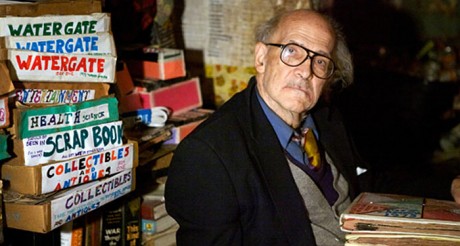If Intuit does its job, a tingling question should nag as you walk out of its doors: if that’s outsider art, am I an outsider?
What you saw inside may have so resonated within you that it hemorrhaged the art-evaluation center of the brain, the pre-tentious cortex. Possibly irreparably. You may conclude that art is infinitely more interesting as a form of communication than when it’s playing hard to get. You may wish to renounce the slightly smug connotations of “outsider art” and align yourself with people who want to provoke questions with you, not “insiders” who volley them toward the space directly above your head, or occasionally, at you.
What is striking about “Almost There: A Portrait of Peter Anton” is how threatening it’s not. The installation presents the work of a disarmingly non-derelict 78 year old eccentric from East Chicago who lives in decrepitude but paints happiness. His paintings themselves are only a small part of the collection. Surrounding each of his works on the walls is Anton memorabilia—photographs of his house, selections from his scrapbooks, and handwritten notes to you, his evaluator. By not allowing his output to stand alone, the curators meet the cheeriness of his paintings with a reciprocating melancholy that portrays the artist and not just his work.
See, Peter Anton lives in a dilapidated petri dish somewhere in Indiana. Many photographs on the walls show the master at work inside his crumbling house. Paint exists only in chips. Mold consumes. Light can’t quite get around the accumulated stacks of scrapbooks. It looks like a wrinkly white spider crawled out from the floorboards and started feeling. The photographs of his house, shot by the curators, are some of the most compelling images of the exhibit. It is candid insight into the mind of an old, troubled man; one gets the impression that the 78-year olds who don’t live in this type of hoarder-nightmare squalor are disingenuous with their own minds or just don’t have the guts.

His paintings, though, are irrepressibly bright and optimistic. “As long as I can serve others I will still be alive,” he writes. But his paintings are not servile; they are uplifting because they are flattering. Anton chooses to represent his subjects at their most glowing. He paints regular people hamming it for a camera or having just finished a performance at a talent contest. His approach makes you think to ask, why must Regular People portrayals always celebrate the mundane? Don’t we have our glory days too?
It is here that the portrait of Peter Anton truly emerges. Even as his house falls apart he is fulfilled by preserving the happiness of others. The perfect smiles immortalized by imperfect, untrained strokes take on the gravity of an affirmation that might be all Anton really has.
And that, ultimately, is what makes him an outsider artist. The impetus of his art is not to academically poke at reality, it is to utilize the full emotional range of reality—represented by real people—to transcend the drudgery that too often monopolizes that label.
Intended or not, this exhibit glances off of the sides of happiness and thereby achieves as accurate a portrait of it as I’ve ever seen. Anton’s happiness is not perfection or contentedness. It is resilience. His art and the exhibit are eloquent testaments to the power of a smile. I left feeling luckier and more aware than I did before.
“Almost There: A Portrait of Peter Anton”
Thru December 30, 2010
Intuit: The Center for Intuitive and Outsider Art
756 N. Milwaukee Ave.
Chicago, IL 60642
(312) 243-9088